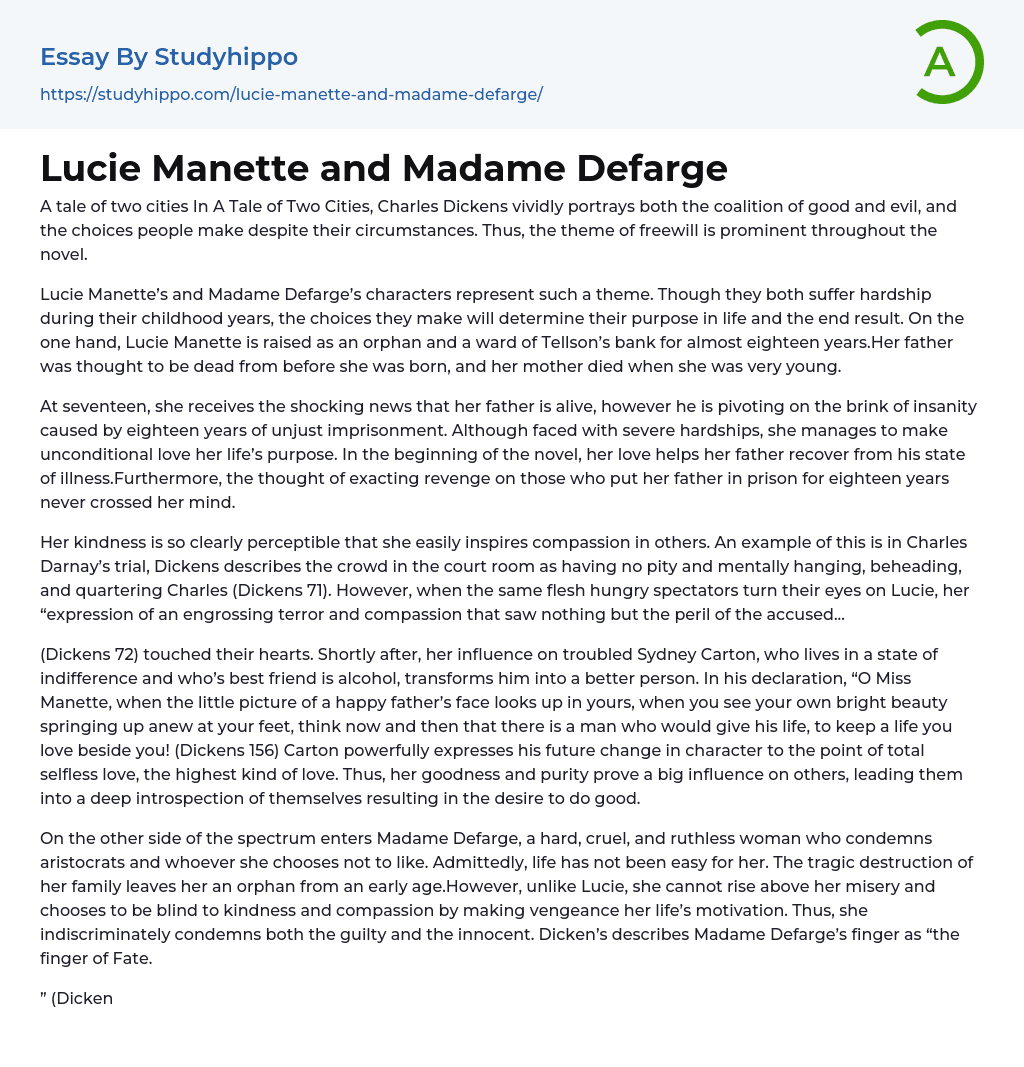A tale of two cities In A Tale of Two Cities, Charles Dickens vividly portrays both the coalition of good and evil, and the choices people make despite their circumstances. Thus, the theme of freewill is prominent throughout the novel.
Lucie Manette’s and Madame Defarge’s characters represent such a theme. Though they both suffer hardship during their childhood years, the choices they make will determine their purpose in life and the end result. On the one hand, Lucie Manette is raised as an orphan and a ward of Tellson’s bank for almost eighteen years.Her father was thought to be dead from before she was born, and her mother died when she was very young.
At seventeen, she receives the shocking news that her father is alive, however he is pivoting on the brink of insanity caused by eighteen years of unjust imprisonm
...ent. Although faced with severe hardships, she manages to make unconditional love her life’s purpose. In the beginning of the novel, her love helps her father recover from his state of illness.Furthermore, the thought of exacting revenge on those who put her father in prison for eighteen years never crossed her mind.
Her kindness is so clearly perceptible that she easily inspires compassion in others. An example of this is in Charles Darnay’s trial, Dickens describes the crowd in the court room as having no pity and mentally hanging, beheading, and quartering Charles (Dickens 71). However, when the same flesh hungry spectators turn their eyes on Lucie, her “expression of an engrossing terror and compassion that saw nothing but the peril of the accused...
(Dickens 72) touched their hearts. Shortly after, her influence o
troubled Sydney Carton, who lives in a state of indifference and who’s best friend is alcohol, transforms him into a better person. In his declaration, “O Miss Manette, when the little picture of a happy father’s face looks up in yours, when you see your own bright beauty springing up anew at your feet, think now and then that there is a man who would give his life, to keep a life you love beside you! (Dickens 156) Carton powerfully expresses his future change in character to the point of total selfless love, the highest kind of love. Thus, her goodness and purity prove a big influence on others, leading them into a deep introspection of themselves resulting in the desire to do good.
On the other side of the spectrum enters Madame Defarge, a hard, cruel, and ruthless woman who condemns aristocrats and whoever she chooses not to like. Admittedly, life has not been easy for her. The tragic destruction of her family leaves her an orphan from an early age.However, unlike Lucie, she cannot rise above her misery and chooses to be blind to kindness and compassion by making vengeance her life’s motivation. Thus, she indiscriminately condemns both the guilty and the innocent. Dicken’s describes Madame Defarge’s finger as “the finger of Fate.
” (Dickens 265) Throughout the novel, she is “something of a force of nature. ” (Shmoop Editorial Team) Her bitterness turns into a powerful force for evil, bringing out the worst in others. Thus, she is able to rally a mob of ordinary women into killing and pursuing revenge. Dickens 215) Furthermore, unlike lighthearted Lucie, she has the capability to
inspire intense fear, “We are more afraid of you than of these others,” Lucie tells her, which Madame Defarge receives as a compliment.
(Dickens 265) Even Miss Pross, Lucie Manette’s devoted servant and protector graphically illustrates this point when she tells Madame Defarge, “You might, from your appearance, be the wife of Lucifer. ” (Dickens 358) In the end however, both women reap what each has sown. Lucie Manette has been a good wife, loving mother, obedient daughter, and understanding friend throughout the novel.By sowing seeds of joy, peace, patience, and love, in the end she therefore reaps the most desired treasure of all, LIFE. At the other end of the spectrum, Madame Defarge throughout the novel has been a terrorizing human tornado.
All her seeds had one motive, hate. By sowing murder, revenge, and fear, she reaps what can only be expected, DEATH.Work Cited Dickens, Charles. “A Tale of Two Cities.
” New York: Penguin Putnam Inc, 1997. Shmoop Editorial Team. "Madame Defarge Timeline in A Tale of Two Cities. " Shmoop.
com. Shmoop University, Inc. , 11 Nov. 2008. Web.
06 Feb 2011.
- 1984 essays
- A Farewell to Arms essays
- A Good Man Is Hard to Find essays
- A Hanging essays
- A Lesson Before Dying essays
- A Long Way Gone essays
- A Rose For Emily essays
- A Separate Peace essays
- A Tale Of Two Cities essays
- A Very Old Man With Enormous Wings essays
- Adventures Of Huckleberry Finn essays
- Alice in Wonderland essays
- All Quiet on The Western Front essays
- Allegory of the Cave essays
- An occurrence at owl creek bridge essays
- Animal Farm essays
- Anthem essays
- Antigone essays
- Arthur Conan Doyle essays
- As I Lay Dying essays
- Atticus Finch essays
- Barn Burning essays
- Battle Royal essays
- Beauty and The Beast essays
- Beloved essays
- Boo Radley essays
- Brave New World essays
- Candide essays
- Castle essays
- Characters In Hamlet essays
- Characters In Romeo And Juliet essays
- Christmas carol essays
- Chronicle of a Death Foretold essays
- Cinderella essays
- Crime and Punishment essays
- Daisy Miller essays
- Death of a Salesman American Dream essays
- Desdemona essays
- Diary Of A Wimpy Kid essays
- Dracula essays
- Dubliners essays
- Emma essays
- Ender'S Game essays
- Ethan Frome essays
- Eveline essays
- Fahrenheit 451 essays
- First-Person Narrative essays
- Fish Cheeks essays
- Frankenstein essays
- Genesis essays




